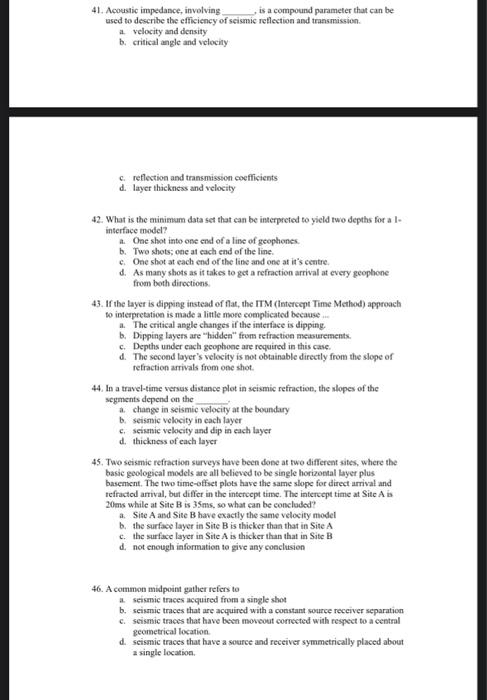Answered step by step
Verified Expert Solution
Question
1 Approved Answer
can you solve these except 42 41. Acoustic impedance, involving , is a compound parameter that can be used to describe the efficiency of scismic
can you solve these except 42 
41. Acoustic impedance, involving , is a compound parameter that can be used to describe the efficiency of scismic reflection and transmission. a. velocity and density b. critical angle and velocity c. reflection and transmission coefficients d. layer thickness and velocity 42. What is the minimum data set that can be interpected to yield two depths for a Iinterface model? a. One shot into one end of a line of geophones. b. Two shots; one at each end of the line. c. One shot at each end of the line and one at it"s centre. d. As many shots as it takes to get a refraction arrival at every geophone from both directions. 43. If the layer is dipping instead of flat, the ITM (Intereept Time Method) approach to inferpretation is nade a little more complicated because ... a. The critical angle changes if the interface is dipping. b. Dipping layers are "hiddea" frum refraction metsurenents. c. Depths under each geophone are required in this case. d. The second layer's velocity is not obtainable directly from the slope of refraction arrivals from one shot. 44. In a travel-time versus distance plot in seismic refraction, the slopes of the segments depend on the a. change in seismic velocity at the boundary b. seismic velocity in cach layer c. seismic velocity and dip in each layer d. thickness of each layer 45. Two seismic refraction surveys have been done at two different sites, where the basic goological models are all believed to be single horizontal layer plus basement. The two time-offiet plots have the same slope for direct arrival and refracted arrival, but differ in the intercept time. The intercept time at Site A is 20 ms while at Site B is 35ms, so what can be concloded? a. Site A asd Site B have exactly the same velocity model b. the surface layer in Site B is thicker than that in Site A c. the surface layer in Site A is thicker than that in Site B d. not enough information to give any conchusion 46. A common midpoint gather refers to a. seismic traces acquired from a single shot b. seismic traces that are acquired with a constant source receiver separation c. seismic traces that have been moveout corrected with respect to a central geometrical location. d. Seismic traces that have a source and receiver symmetrically placed about a single location 
Step by Step Solution
There are 3 Steps involved in it
Step: 1

Get Instant Access to Expert-Tailored Solutions
See step-by-step solutions with expert insights and AI powered tools for academic success
Step: 2

Step: 3

Ace Your Homework with AI
Get the answers you need in no time with our AI-driven, step-by-step assistance
Get Started


